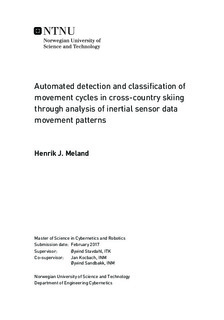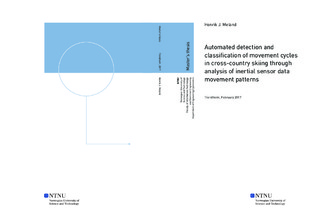| dc.description.abstract | Published technique analysis tools for movement patterns in cross-country skiing have accuracies ranging from 88% up to 98.5%, but reviews of these studies reveals that none have thoroughly addressed classifier robustness across variations in terrain, athlete skill level and movement intensity, in addition to none being proven able to classify both classical and skating technique without technique specific alterations. This thesis has therefore suggested an approach of using a template matching based classifier, with its main goal being identifying and classifying movement cycles of both cross-country skating and classical subtechniques, in addition to providing estimates of cycle times for each cycle.
Investigations found variation in parameters of characteristics and terrain of significant impact to the classifier, whilst variations in movement intensity had less effect. The final template matching implementation was tested on three different athletes, doing full laps of varied terrain and choosing technique freely. Video analysis of these recordings found 649 valid movement cycles, of these 616 were detected correctly. A total of 575 of the correctly detected cycles were classified correctly, resulting in an overall classification rate of 88.6\%. Cycle time calculations were implemented and compared against the video annotations, with results showing strong consistency and coherence between them.
Specific challenges were tied to the most prominent misclassifications, and are believed solvable through further investigations. If these issues were solved properly overall classifier performance for the current implementation would elevate to 94.3%. Common challenges within the field regarding turns and transitioning were also seen for this method. Real-time implications have been evaluated, conclusions being that conversion into real-time functionality is possible through simple alterations to the sequential execution of the algorithm.
These results are considered promising in developing a classifier capable of handling movement patterns of both classical and skating techniques, as the first method within the field to handle both classical and skating without technique specific alterations. The method is based solely on general templates representing movements, thus utilizing this algorithm on other fields of cyclic movement should only require an alteration of the template base used. | |

